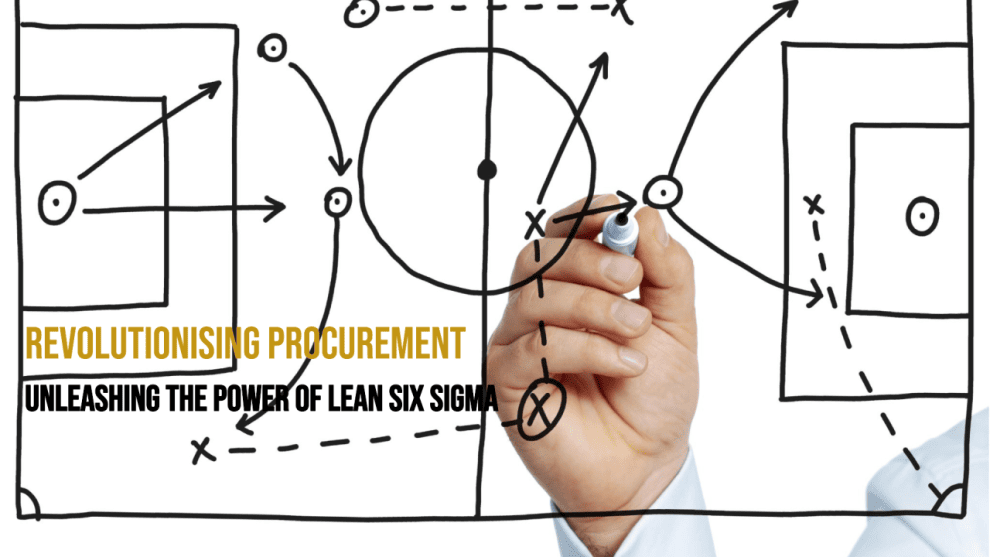Revolutionising Procurement: Unleashing the Power of Lean Six Sigma

Lean Six Sigma extends beyond a methodology; it’s a lens through which we can view and transform procurement practices. Let’s delve into the profound impact Lean Six Sigma can have on revolutionising the procurement landscape.
Streamlining Procurement Processes with Lean Six Sigma
Procurement, a multifaceted process involving numerous stakeholders, often encounters inefficiencies and complexities. Lean Six Sigma provides a systematic approach to identify and eliminate waste, optimise workflows, and enhance overall efficiency. Lean Six Sigma is a guiding force in streamlining procurement processes, reducing cycle times, and minimising unnecessary activities.
Case Studies of Successful Lean Six Sigma Implementations
Real-world success stories highlight the transformative power of Lean Six Sigma in procurement. When a client who faced challenges with sourcing critical components efficiently adopted Lean Six Sigma methodologies, the procurement team not only streamlined the sourcing process but also achieved a significant reduction in its total cost through strategic negotiations and collaborative efforts with key suppliers, simultaneously enhancing customer satisfaction.
Another noteworthy case study, this time focusing on Strategic Relationship Management (SRM), showcases how Lean Six Sigma can connect the supply chain with the strategic interests of an organisation. In this case, the procurement team took a strategic approach to identify and nurture key supplier relationships. By aligning supply chain activities with the organisation’s strategic goals, they successfully uncovered untapped business opportunities. This approach to SRM not only improved supplier collaboration but also contributed to the organisation’s overall growth and competitiveness.
Another case study reveals what happens when you apply Lean Six Sigma principles to the end-to-end procurement lifecycle. Through the systematic use of tools like DMAIC, we dissected the procurement workflow, identifying bottlenecks and areas for improvement. The result was a significant reduction in cycle times, allowing for quicker responses to procurement requests and an overall more efficient process.
Building a Lean Procurement Culture
Embedding Lean Six Sigma into the procurement culture requires more than just adopting tools; it necessitates a cultural shift. Leadership commitment, employee engagement, and a continuous improvement mindset are crucial elements in creating a lean procurement culture.
The successful integration of Lean Six Sigma into the procurement culture involves clear communication and the implementation of a process maturity framework. Leadership support plays a key role in fostering an environment where continuous improvement isn’t just a goal but a shared commitment. Workshops and regular huddles ensures everyone understands the principles and they feel empowered to contribute ideas for improvement.
Simultaneously, implementing the process maturity framework is a significant catalyst in cultivating a lean process mindset culture within the procurement team. Beyond solely focusing on enhancing efficiencies, this framework contributes to an uplifting of morale and empowerment. Serving as a valuable tool for benchmarking, the process maturity model enables the procurement team to assess their standing in comparison to broader industry patterns. Additionally, the model facilitates the evaluation of the present state of procurement processes, identifies the maturation stage, and pinpoints specific interventions for improvement. In essence, the process maturity framework is an invaluable element in fostering a lean culture, empowering procurement process owners to guide their teams towards process excellence
Key Lean Six Sigma Tools for Procurement Professionals
Procurement professionals frequently encounter challenges such as supplier delays, communication gaps, and inefficient approval processes. The application of Lean Six Sigma tools and principles provides a structured and systematic approach to effectively address these challenges.
One indispensable tool that has consistently proven highly effective is the adept application of problem-solving skills—a fundamental aspect of Lean Six Sigma. This proficiency is effectively harnessed through the structured Plan-Do-Check-Act (PDCA) cycle. This strategic approach empowers procurement professionals not only to clearly define a problem statement and goal statement but also to identify challenges, develop and implement targeted solutions, and continually monitor and refine processes for ongoing improvement. A pivotal phase in my professional journey centres around delivering training sessions focused on refining problem-solving abilities, instilling PDCA concepts, and fostering team empowerment. These sessions aimed not only to cultivate a self-improvement culture within the team but also to amplify their awareness of the invaluable benefits inherent in Lean Six Sigma. The impact of these initiatives manifested not only in enhanced processes but also in cultivating a more engaged and empowered team.
Value Stream Mapping (VSM) is another incredible tool for procurement professionals. VSM serves as a powerful visualisation tool for the entire procurement process, offering a comprehensive overview. Through VSM, you can identify non-value-added steps, paving the way for targeted improvements. This strategic use of VSM results in the optimization of the procurement workflow, significantly reducing lead times, and enhancing overall process efficiency.
Lean Six Sigma emerges as a transformative force in procurement, offering a systematic approach to streamline processes, foster a culture of continuous improvement, and address common challenges. The Lean Six Sigma success stories and tools highlight the versatility and adaptability of Lean Six Sigma in diverse procurement contexts.
As procurement professionals, embracing Lean Six Sigma is not just a strategic choice; it’s a commitment to shaping a leaner, more efficient future for procurement. The journey may present challenges, but with the right mindset, tools, and a collaborative spirit, the destination is one of sustained success.
How has Lean Six Sigma influenced your procurement practices? Let’s continue the conversation and collectively contribute to the ongoing revolution in procurement through Lean Six Sigma.
Contact Lean Six Sigma expert Ricardo Fainbaum







 We are all about sharing our expertise to help you and your organisation be the best it can be.
We are all about sharing our expertise to help you and your organisation be the best it can be.